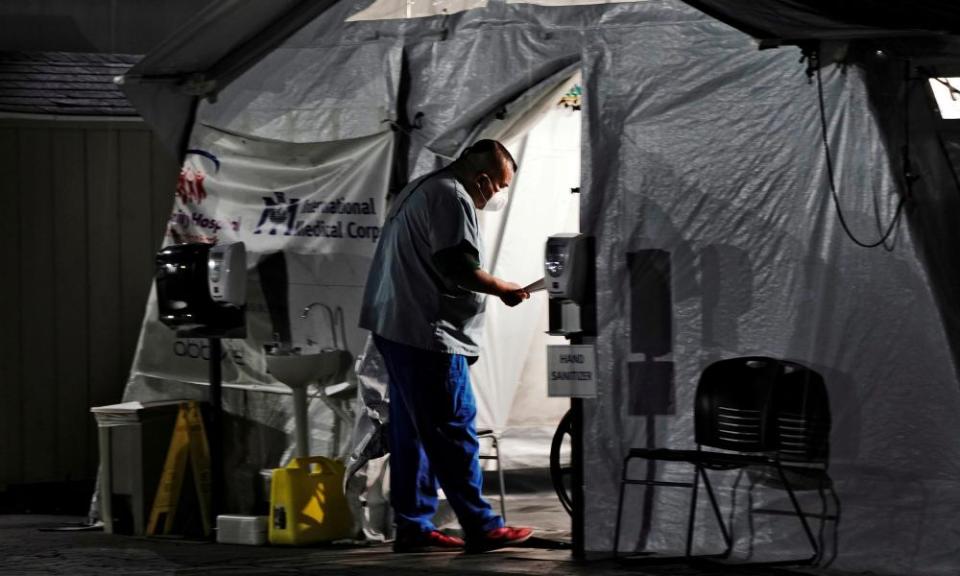At least 400 US healthcare workers have died of Covid despite vaccine rollout

As healthcare workers in the US began lining up for their first coronavirus vaccines on 14 December, Esmeralda Campos-Loredo was already fighting for oxygen.
The 49-year-old nursing assistant and mother of two had started having breathing problems just days earlier. By the time the first of her co-workers were getting shots, she was shivering in a tent in the parking lot of a Los Angeles hospital, because no medical beds were available. When she gasped for air, she had to wait all day for relief because there was a critical shortage of oxygen tanks.
Related: 'It doesn't feel worth it': Covid-19 is pushing New York's EMTs to the brink
Campos-Laredo died of Covid-19 on 18 December, one of at least 400 health workers identified by the Guardian/KHN’s Lost on the frontline investigation who have died since the vaccine became available in mid-December, narrowly missing the protection that might have saved their lives.
“I told her to hang in there, because they are releasing the vaccine,” said her daughter Joana Campos. “But it was just a little too late.”
In California, which became the center of the national coronavirus surge following Thanksgiving, 40% of all healthcare worker deaths came after the vaccine was being distributed to medical staff.
An analysis of the Guardian/KHN’s Lost on the Frontline database indicates that at least one in eight health workers lost in the pandemic died after the vaccine became available. Unlike California, many states do not require a thorough reporting of the deaths of nurses, doctors, first responders and other medical staff. The analysis did not include federally reported deaths where the name was not released and may be missing numerous recent deaths that have not yet been detected by the Guardian/KHN.
The vaccine is now widely available to healthcare workers around the country and since mid-January, Covid-19 cases have been trending downward in the US.
Sasha Cuttler, a nurse in San Francisco, has been gathering healthcare data for one of California’s nursing unions. Cuttler was alarmed and disheartened to see the number of deaths still surging weeks after the vaccination became widely available. “We can prevent this. We just need the means to do it,” said Cuttler, who noted that, nearly a year into the pandemic, some hospitals still lack adequate protective gear and proper staffing. “We don’t want to be healthcare heroes and martyrs. We want a safe workplace.”
Barbara Clayborne, a nurse in Stockton, became sick the week her colleagues started receiving their first doses of the vaccine.
A union activist who had worked at St Joseph’s medical center for 22 years, Clayborne picketed last summer to demand more help for the beleaguered nurses treating Covid-19 patients.
Though she worked on what was considered a relatively low-risk postpartum care unit, she was advocating for her colleagues in the intensive care unit, many of whom were overwhelmed by the number of patients they were responsible for.
“We know what it’s like to work a full 12-hour shift and not be able to drink water or sit down or go to the bathroom,” Clayborne told the Stockton Record in August. “It’s been chaos.”
In mid-December, Clayborne, who had asthma, was exposed to a patient who hadn’t yet been diagnosed with Covid-19, said her daughter Ariel Bryant. She died on 8 January.
“She was the best mom and grandmother – and she was a great role model for me,” said Bryant, who herself became a nurse. Bryant works in an intensive care unit in southern California – as the same type of nurse her mother fought so hard to protect.
If the vaccine had just come a few days earlier, it might have saved the Tennessee fire chief Ronald “Ronnie” Spitzer and his department’s dispatcher, Timothy Phillips.
Spitzer and his crew from the Rocky Top fire department were called to a medical emergency on 11 December but weren’t told until later that the patient had tested positive for Covid-19. Spitzer, 65, and the firefighter who accompanied him came down with the virus. A few days later, Phillips became ill as well.
Spitzer, a 47-year firefighting veteran, was already hospitalized when his co-workers got their first doses of the vaccine in January, according to the police chief, Jim Shetterly. Spitzer died on 13 January, and Phillips, 54, died a few days later.
Tennessee does not publish statistics on healthcare worker deaths, but 10 of 22 Tennessee healthcare worker deaths identified by the Guardian/KHN have occurred since the vaccine rollout in December.
Shetterly said his town of 1,800 had been shattered by the losses. “Everyone knows everyone here. It’s tragic when it hits the nation. But when it’s in your town, it really hits home,” he said.
Gerard Brogan, director of nursing practice for National Nurses United, said many hospitals hadn’t done adequate planning to be ready for the recent surges, which put exhausted healthcare workers at extra risk.
“When there are more patients in, there’s more chaos in the hospitals and it’s harder for workers to be safe,” he said. During the recent surge, “we had nurses breaking down because of the influx of patients and the emotional and physical toll that took on workers”.
Even once all healthcare workers were vaccinated, he said, healthcare administrators would need to remain vigilant about worker safety.
He said that surge preparations, extra safety equipment, contingency staffing plans and facilities like negative-pressure rooms to stop disease from spreading around hospitals should be a regular part of preparing for potential future pandemics.
Rashida Kamal and KHN reporters Shoshana Dubnow and Christina Jewett contributed to this report

 Yahoo Finance
Yahoo Finance 